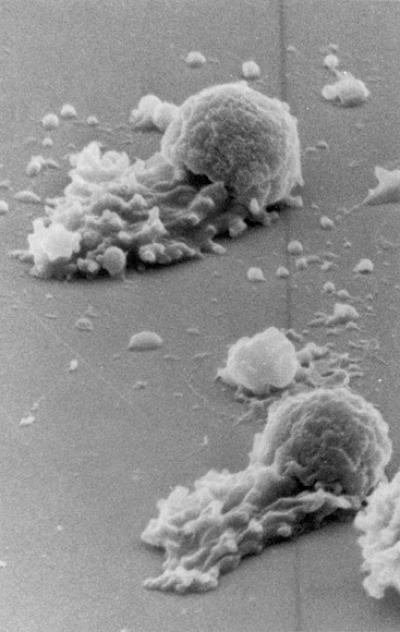Cells are crawling all over our bodies, but how?
October 20, 2011

An electron microscope image of two crawling worm sperm magnified ~5,000X (credit: Tom Roberts, FSU Dept. of Biological Science)
Florida State University cell biologist Tom Roberts and his research team have found a novel way to study cell mobility that could lead to development of therapies that target cell motility to interfere with or block the metastasis of cancer, for example.
For better and for worse, human health depends on a cell’s motility — the ability to crawl from place to place. In every human body, millions of cells — are crawling around doing mostly good deeds — though if any of those crawlers are cancerous, watch out.
“This is not some horrible sci-fi movie come true but, instead, normal cells carrying out their daily duties,” said Roberts. For 35 years he has studied the mechanical and molecular means by which amorphous single cells purposefully propel themselves throughout the body in amoeboid-like fashion — absent muscles, bones or brains.
Meanwhile, human cells don’t give up their secrets easily. In the body, they use the millions of tiny filaments found on their front ends to push the front of their cytoskeletons forward. In rapid succession, the cells then retract their rears in a smooth, coordinated extension-contraction manner that puts inchworms to shame. Yet take them out of the body and put them under a microscope and the crawling changes or stops.
In a landmark study led by Roberts and conducted in large part by his then-FSU postdoctoral associate Katsuya Shimabukuro, researchers used worm sperm to replicate cell motility in vitro — in this case, on a microscope slide.
Doing what no other scientists had ever successfully done before, Shimabukuro disassembled and reconstituted a worm sperm cell, then devised conditions to promote the cell’s natural pull-push crawling motions even in the unnatural conditions of a laboratory. Once launched, the reconstituted machinery moved just like regular worm sperm do in a natural setting — giving scientists an unprecedented opportunity to watch it move and making possible new, revealing images of cell motility that should help to pinpoint with never-before-seen precision just how cells crawl.
“The first line of defense against invading microorganisms, the remodeling of bones, healing wounds in the skin and reconnecting of neuronal circuits during regeneration of the nervous system — all depend on the capacity of specialized cells to crawl,” Roberts said.
“On the downside, the ability of tumor cells to crawl around is a contributing factor in the metastasis of malignancies,” he said. “But we believe our achievements in this latest round of basic research could eventually aid in the development of therapies that target cell motility in order to interfere with or block the metastasis of cancer.”
Armed with the new-found ability to reconstitute amoeboid motility in vitro, cell biologists such as Roberts may be able to learn the answers to some major moving questions. Among them: How can some cells continue to crawl even after researchers have disabled their supply of myosin, the force-producing “mover protein” that functions like a motor to help power muscle and cell contraction?
For Roberts and his team, the next move will be to determine if what they’ve learned about worm sperm also applies to more conventional crawling cells, including tumor cells.
“As always, there will be more questions,” Roberts said. “Are there multiple mechanisms collaborating to drive cell body retraction? Is there redundancy built into the motility systems?”
Ref.: Katsuya Shimabukuro, et al., Reconstitution of Amoeboid Motility In Vitro Identifies a Motor-Independent Mechanism for Cell Body Retraction, Current Biology, 2011; [DOI: 10.1016/j.cub.2011.08.047]